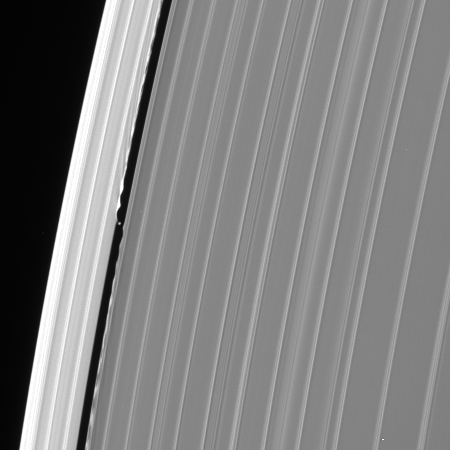Saturn’s rings, warped by one of Saturn’s moons
Cool image time! Rather than post another Mars image, I decided today to dig into the archive left from the Cassini orbiter that circled Saturn from July 1, 2004 until September 15, 2017. The picture to the right, cropped to post here, was taken on September 13, 2017, only two days before the orbiter burned up in Saturn’s atmosphere. From the caption:
This image of Saturn’s outer A ring features the small moon Daphnis and the waves it raises in the edges of the Keeler Gap. The image was taken by NASA’s Cassini spacecraft on Sept. 13, 2017. It is among the last images Cassini sent back to Earth. The view was taken in visible light using the Cassini spacecraft wide-angle camera at a distance of 486,000 miles from Saturn. Image scale is 2.7 miles [per pixel].
The moon is traveling downward in this image. As it moves past the outer ring, its gravity causes that edge to ripple, producing the waves.
The scale will give you an idea of how big the rings of Saturn are. The Keeler Gap is at the outer edge of the A ring of Saturn, which is the outermost ring that is clearly visible using ordinary amateur telescopes. That edge however is more than 90,000 miles from Saturn. And grayish bands to the right of Daphne and the Keeler Gap are only the outer half of the A ring, which is by itself about 9,000 miles wide.
On Christmas Eve 1968 three Americans became the first humans to visit another world. What they did to celebrate was unexpected and profound, and will be remembered throughout all human history. Genesis: the Story of Apollo 8, Robert Zimmerman's classic history of humanity's first journey to another world, tells that story, and it is now available as both an ebook and an audiobook, both with a foreword by Valerie Anders and a new introduction by Robert Zimmerman.
The print edition can be purchased at Amazon or from any other book seller. If you want an autographed copy the price is $60 for the hardback and $45 for the paperback, plus $8 shipping for each. Go here for purchasing details. The ebook is available everywhere for $5.99 (before discount) at amazon, or direct from my ebook publisher, ebookit. If you buy it from ebookit you don't support the big tech companies and the author gets a bigger cut much sooner.
The audiobook is also available at all these vendors, and is also free with a 30-day trial membership to Audible.
"Not simply about one mission, [Genesis] is also the history of America's quest for the moon... Zimmerman has done a masterful job of tying disparate events together into a solid account of one of America's greatest human triumphs."--San Antonio Express-News
Cool image time! Rather than post another Mars image, I decided today to dig into the archive left from the Cassini orbiter that circled Saturn from July 1, 2004 until September 15, 2017. The picture to the right, cropped to post here, was taken on September 13, 2017, only two days before the orbiter burned up in Saturn’s atmosphere. From the caption:
This image of Saturn’s outer A ring features the small moon Daphnis and the waves it raises in the edges of the Keeler Gap. The image was taken by NASA’s Cassini spacecraft on Sept. 13, 2017. It is among the last images Cassini sent back to Earth. The view was taken in visible light using the Cassini spacecraft wide-angle camera at a distance of 486,000 miles from Saturn. Image scale is 2.7 miles [per pixel].
The moon is traveling downward in this image. As it moves past the outer ring, its gravity causes that edge to ripple, producing the waves.
The scale will give you an idea of how big the rings of Saturn are. The Keeler Gap is at the outer edge of the A ring of Saturn, which is the outermost ring that is clearly visible using ordinary amateur telescopes. That edge however is more than 90,000 miles from Saturn. And grayish bands to the right of Daphne and the Keeler Gap are only the outer half of the A ring, which is by itself about 9,000 miles wide.
On Christmas Eve 1968 three Americans became the first humans to visit another world. What they did to celebrate was unexpected and profound, and will be remembered throughout all human history. Genesis: the Story of Apollo 8, Robert Zimmerman's classic history of humanity's first journey to another world, tells that story, and it is now available as both an ebook and an audiobook, both with a foreword by Valerie Anders and a new introduction by Robert Zimmerman.
The print edition can be purchased at Amazon or from any other book seller. If you want an autographed copy the price is $60 for the hardback and $45 for the paperback, plus $8 shipping for each. Go here for purchasing details. The ebook is available everywhere for $5.99 (before discount) at amazon, or direct from my ebook publisher, ebookit. If you buy it from ebookit you don't support the big tech companies and the author gets a bigger cut much sooner.
The audiobook is also available at all these vendors, and is also free with a 30-day trial membership to Audible.
"Not simply about one mission, [Genesis] is also the history of America's quest for the moon... Zimmerman has done a masterful job of tying disparate events together into a solid account of one of America's greatest human triumphs."--San Antonio Express-News



To Titan!
https://phys.org/news/2025-11-satellite-constellations-future-missions-titan.html
Colonizing worlds–YEAH–I SAID COLONIZING!
https://phys.org/news/2025-11-archaeologist-colonizing-worlds.html